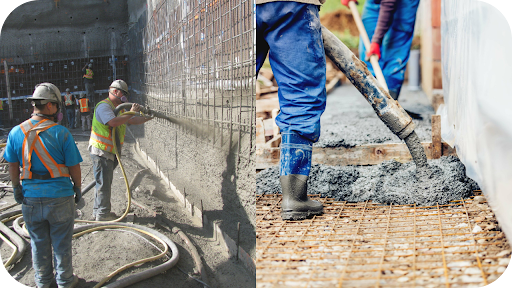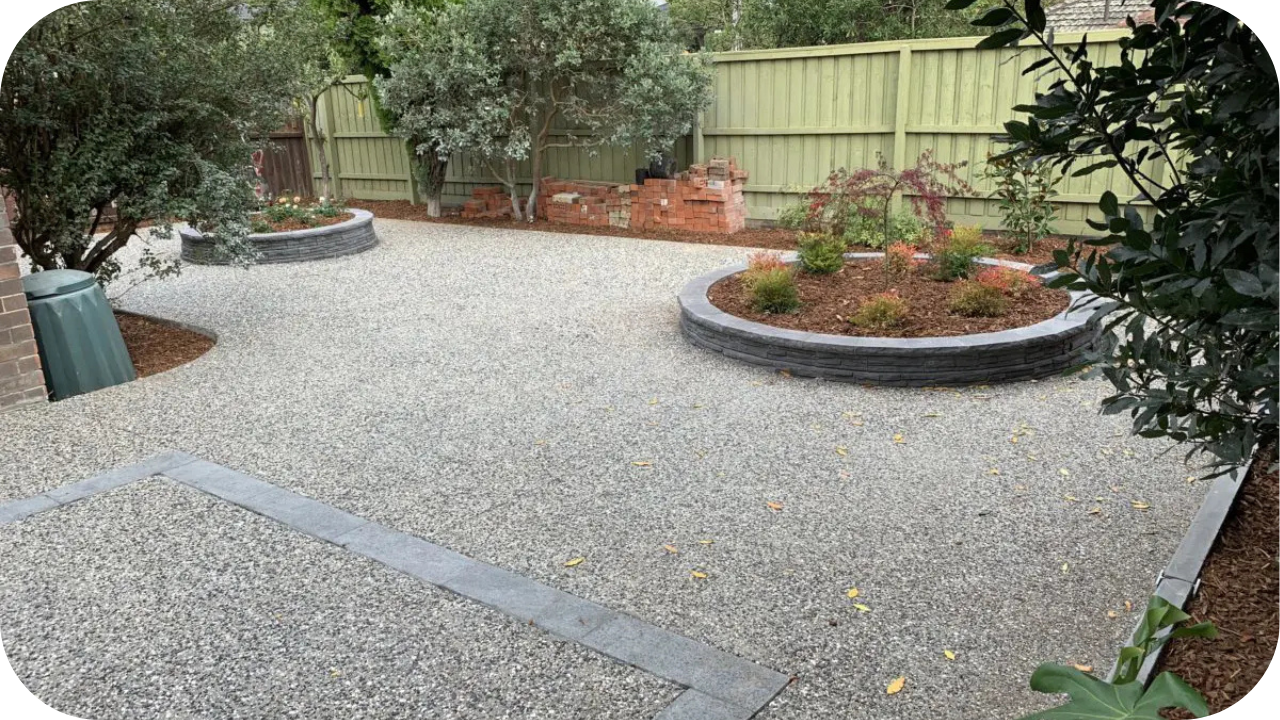


When it comes to modern concrete construction methods, two options often stand out: shotcrete and poured concrete. Each technique brings its own advantages, making them suitable for different project needs.
While shotcrete offers speed and flexibility for complex surfaces, poured concrete delivers consistency and reliability for foundations and slabs.
This article compares both approaches, weighing their strengths and limitations, to help you decide which method is the right fit for your construction project.
Shotcrete is a specialised concrete application method where the material is sprayed onto a surface at high velocity using a hose and nozzle. It can be applied as a dry mix, where water is added at the nozzle, or as a wet mix, pre-mixed before spraying.
This process creates a dense, durable layer of concrete that bonds strongly to surfaces. Shotcrete is particularly useful for curved, vertical, or overhead structures where traditional pouring is challenging.
Common uses include swimming pools, tunnels, retaining walls, and slope stabilisation. By reducing or eliminating the need for formwork, shotcrete speeds up construction and cuts material costs, making it a versatile choice for projects with complex shapes or hard-to-reach areas.
Poured concrete, also called cast-in-place concrete, is the most widely used concrete placement method in construction. It involves pouring mixed concrete into pre-built formwork and then compacting it, often with vibration, to remove air pockets and ensure a solid, uniform structure.
This method delivers consistent results, with smooth finishes and strong encapsulation around reinforcement. Poured concrete is ideal for large-scale, straightforward projects such as house foundations, walls, driveways, and commercial slabs.
Its reliability and cost-effectiveness make it a preferred option for projects where strength and waterproofing are critical. While it requires more time and labour due to formwork setup and removal, poured concrete provides proven durability and structural integrity in a wide range of construction applications.

Although both methods achieve durable results, the way they’re applied, their costs, and their performance vary. Let’s break down the key differences between shotcrete and poured concrete to help you determine which option best suits your construction project:
The main distinction lies in how each method is applied. Shotcrete is sprayed directly onto a surface at high velocity, making it suitable for vertical, curved, or overhead structures. It eliminates many of the challenges associated with complex shapes.
In contrast, poured concrete requires formwork where the concrete is placed, compacted, and allowed to cure. While this produces smooth, uniform finishes, it is less flexible for irregular designs.
The application method you choose will often depend on whether the project involves intricate surfaces or straightforward, flat structures.
Cost plays a significant role when comparing shotcrete vs poured concrete. Shotcrete usually requires specialised equipment and skilled nozzle operators, which can make it more expensive upfront. However, it can save money on formwork and speed up construction timelines, reducing labour costs.
Poured concrete is often more economical for larger, simpler projects where formwork is standard, such as slabs or foundations. Although labour-intensive, its widespread use and familiarity make it cost-effective in most cases.
Choosing between the two depends on whether your priority is reducing formwork costs or lowering labour and equipment expenses.
Both shotcrete and poured concrete offer excellent durability, but they achieve it in different ways. Shotcrete benefits from being pneumatically applied, which compacts the material and enhances its bond with surfaces. This makes it highly resistant in areas like retaining walls, pools, and tunnels.
Poured concrete, on the other hand, achieves strength through consistent placement and vibration that removes air pockets, ensuring a dense, uniform structure.
While poured concrete is often preferred for load-bearing foundations, shotcrete is valued for strong adhesion on irregular or vertical surfaces, giving each method its own advantage depending on project requirements.
One of the biggest differences is the need for formwork. Shotcrete reduces or eliminates this requirement, making it faster and more efficient for projects with complex or hard-to-access areas. This can significantly cut down construction time.
Poured concrete, by contrast, depends on formwork to hold the mixture in place until it sets. While reliable, building and dismantling forms adds time and labour to the process.
For projects where speed and adaptability are crucial, shotcrete is often the better choice, whereas poured concrete remains the standard for straightforward and repeatable builds.

When tackling projects with unique shapes or tight deadlines, not all concrete methods perform the same. Here’s why shotcrete stands out as a flexible and efficient choice for modern construction:
For projects that demand strength, reliability, and long-term performance, traditional methods still have the edge. Here are the key reasons why poured concrete remains a trusted favourite in construction:

Choosing between shotcrete and poured concrete often comes down to project requirements. While both methods deliver strength and durability, each shines in specific situations. Let’s look at the best scenarios for using shotcrete and when poured concrete is the smarter option:
Shotcrete is the preferred method when working on complex or irregular surfaces. It excels in vertical or overhead applications such as retaining walls, swimming pools, tunnels, and slope stabilisation.
Projects that require fast construction timelines also benefit from shortcrete since it eliminates most formwork and can be applied quickly.
It’s also ideal for repair or reinforcement work where accessibility is limited. In short, when versatility, speed, and reduced formwork are priorities, shotcrete is the smarter option.
Poured concrete is best suited for large-scale, straightforward projects where consistency and strength are critical. Common applications include house foundations, basement walls, commercial slabs, driveways, and pathways.
Its uniform placement and superior waterproofing make it particularly effective for load-bearing and below-ground structures. Poured concrete is also cost-effective for standard designs where formwork is easy to construct.
For projects requiring long-term durability, proven strength, and reliable finishes, poured concrete remains the go-to choice.

Selecting the right contractor is just as important as choosing the right concrete method. Here’s why Urban Pour is the trusted partner for projects across Victoria:
Both shotcrete and poured concrete provide unique benefits depending on the scale and requirements of your project. Shotcrete is valued for its speed and versatility, while poured concrete is often preferred for its precision and uniform strength. The important step is choosing the method that delivers long-term durability, cost efficiency, and reliability for your specific needs.
Working with an experienced team ensures that your project not only meets structural demands but also achieves the quality finish you expect. Urban Pour brings technical expertise, modern equipment, and a commitment to excellence on every job, helping you make the right choice from the start.
If you are planning a concrete project, our specialists are here to guide you. Contact Urban Pour today to discuss your goals and secure a solution that combines strength, efficiency, and lasting value.

Shotcrete and poured concrete each offer unique advantages. Choosing between them depends on project size, site access, and structural needs.
See more
Exposed aggregate concrete driveways in Melbourne combine strength with striking design, offering a stylish, low-maintenance finish that lasts.
See more